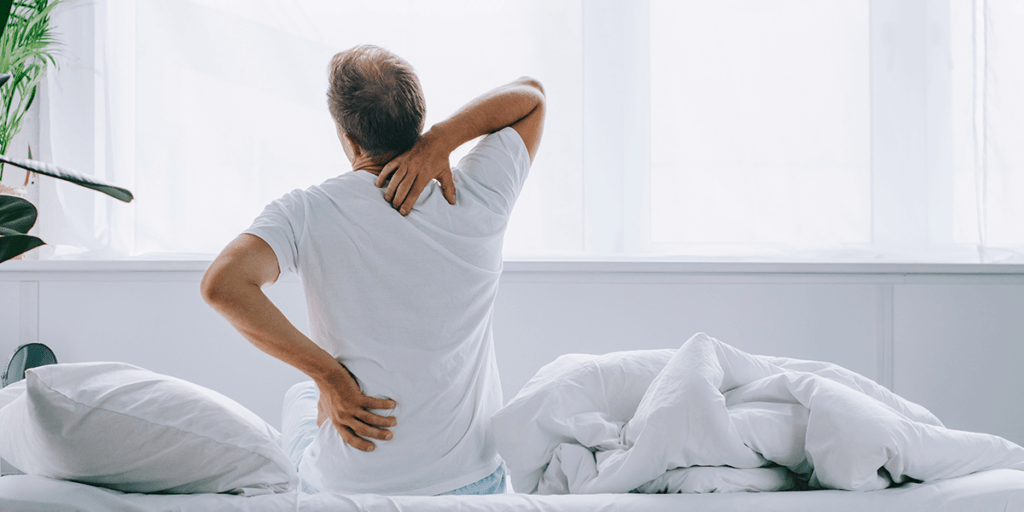

Scoliosis is a sideways spine curvature that affects your postural alignment, resulting in back stiffness or discomfort throughout the day and night. Chronic pain can make it challenging to fall and stay asleep, and tossing and turning all night in search of a comfortable position can leave you fatigued and grumpy the next day.
Modifying your sleep position and resting on a supportive mattress can significantly improve your sleep quality, improving your well-being throughout the day. Learn tips for the best way to sleep with scoliosis in this guide.
You may do physical therapy or at-home exercises to improve your posture, but supporting your spine at night is also essential. If you have scoliosis, sleep modifications can significantly increase your comfort and decrease stiffness when you wake up.
Some professionals believe proper sleep positioning can prevent scoliosis progression. Rest is vital for your physical and mental health. Getting between seven and nine hours of sleep per night is ideal, and learning how to sleep with scoliosis is an excellent way to achieve this.
Lying on your back is typically the best scoliosis sleeping position because it helps your entire spine remain elongated, preventing twisting and bending. However, many people prefer to sleep on their sides or stomachs. Getting a complete night’s rest is always a priority when sleeping with scoliosis, and modifying your overnight body position can help. Consider the following tips to find the best sleep position for you.
Providers usually recommend back sleeping for scoliosis. Your pillow placement can increase your comfort if you have always preferred back sleeping or want to try it.
Put a thin pillow under your neck to avoid propping your head up too high and prevent neck flexion. A strategically placed pillow puts your neck in a more natural, scooped position. If lying on your back with your legs flat on the bed pulls on your pelvis and lifts your lower back into an arched position, slide a few pillows under your knees.
If you prefer sleeping on your right or left side, try to keep your legs and pelvis level. When you are on your side, your top leg is prone to stretch outward and angle down, which tilts the pelvis upward to compensate. A pillow between your knees and ankles puts your top leg in a horizontal position, minimizing asymmetrical tension on your legs and back.
If you have scoliosis, lying on your stomach for an extended period can potentially exacerbate the spine’s arching. Additionally, bending and propping up one knee while lying on your stomach can emphasize your pelvis rotation and shift.
Stomach sleeping can also cause discomfort if your scoliosis has a significant structural component. In this case, a section of your spine may be stiffer than others, causing other parts to overcompensate while you sleep. For example, if your upper spine is stiff, your lower spine may hyperextend when sleeping on your stomach.
You can modify your stomach sleeping position by placing pillows under your abdomen and pelvis. You may need to adjust the pillows’ thickness and placement a few times before finding the most comfortable solution. You want to reduce the arch in your spine without lifting the lower vertebrae too high.
Like back sleeping, you should have a thin pillow under your head to avoid overextending your neck and upper back. Extending both legs straight out also helps support your spine while sleeping on your stomach.
Talking with a spine specialist is the best way to determine your ideal sleeping position. Every scoliosis patient has a unique spine structure, and an experienced specialist can evaluate your condition and progression to recommend the healthiest, most comfortable solution.
Medium-firm mattresses are ideal for people with scoliosis because they offer maximum spinal support, allowing your hips and shoulders to sink slightly without bending your spine. It’s best to avoid an overly firm mattress because it can apply too much pressure to your spine. In contrast, an excessively soft mattress can magnify your spine’s curvature.
Health providers sometimes prescribe a back brace to prevent spine curvature progression. While this is more common for adolescents with scoliosis, some adults benefit from braces. If a spine specialist recommends you wear a back brace, ask them how many hours you should keep it on and if you should wear it at night. Sleeping on your back is typically best when wearing a brace, but your provider can recommend the ideal position based on your spine structure.
If you change your sleep position and try a new mattress but still experience discomfort, scoliosis treatment can help. A spine specialist can evaluate your spine and recommend treatment options such as bracing or surgery. Endoscopic spine surgery can decompress pinched nerves, and a spinal fusion can stop spine curvature progression.
Sleep modifications can help you live comfortably with scoliosis. Adjust your sleep position and rest on a medium-firm mattress to fall asleep faster and wake up feeling refreshed and healthy.
Desert Institute for Spine Care provides compassionate spine care, using minimally invasive surgical interventions and non-surgical solutions to increase your daily comfort. We take a multidisciplinary approach to scoliosis diagnosis and treatment to help our patients enjoy a higher quality of life.
DISC is a leader in minimally invasive spine procedures, and our board-certified surgical specialists have the knowledge and experience to provide you with the best care. Contact us to schedule an appointment and learn how we can help you increase back comfort.